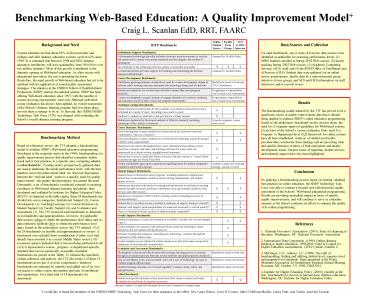Benchmarking WebBased Education: A Quality Improvement Model - PowerPoint PPT Presentation
1 / 1
Title:
Benchmarking WebBased Education: A Quality Improvement Model
Description:
... UMDNJ School of Health-Related Professions (SHRP) mirrors the national picture. ... Intended learning outcomes are reviewed regularly to ensure clarity, utility, ... – PowerPoint PPT presentation
Number of Views:51
Avg rating:3.0/5.0
Title: Benchmarking WebBased Education: A Quality Improvement Model
1
Benchmarking Web-Based Education A Quality
Improvement Model
Craig L. Scanlan EdD, RRT, FAARC
Background and Need Current estimates are that
about 85 of all universities and colleges and
offer distance education courses, up from 62
since 1998.1 It is estimated that between 1998
and 2002, distance education enrollments will
have quadrupled, from 500,000 to over two million
students.2 Most of this growth is attributed to
the dramatic upsurge in Web-based education. As
often occurs with educational innovation, the
cart is preceding the horse. Heretofore, the
rapid growth in Web-based education has yet to be
matched with the application of sound quality
assessment strategies. The situation at the UMDNJ
School of Health-Related Professions (SHRP)
mirrors the national picture. SHRP has been
offering Web-based education since 1997, with the
number of courses growing exponentially each
year. Although individual course evaluation has
always been applied, no overall assessment of the
Schools distance learning program had ever taken
place, nor was there a strategy to do so. To that
end, the UMDNJ-SHRP Technology Task Force (TTF)
was charged with evaluating the Schools overall
distance learning program.
Data Sources and Collection For each benchmark,
one or more of four key data sources were
identified as applicable for assessing
performance levels (1) SHRP students enrolled in
Spring 2002 Web courses, (2) faculty teaching
Spring 2002 Web courses, (3) Academic Computing
Services (ACS) staff, and (4) the SHRP Office of
Enrollment ease of Services (OES). Student data
were gathered via an online survey questionnaire,
faculty data by a semi-structured group interview
(focus group), and ACS and OES information via
staff interviews and/or records review.
Results The benchmarking model selected by the
TTF has proved to be a significant source of
quality improvement data that is already being
applied to enhance SHRPs online education
programming. Based on the preliminary benchmark
review process alone, the need for (1) separate
approval guidelines for Web-based courses, (2)
revision of the Schools course evaluation form,
and (3) a Program- or Department-level CQI
framework for online courses have all been
established. Analysis of student and
faculty-provided data corroborate these findings
and are providing clear and specific direction in
terms of both curriculum and faculty development
needs. General issues of regarding student
services and technical support have also been
highlighted.
Benchmarking Method Based on a literature
review, the TTF adopted a benchmarking model to
evaluate SHRPs Web-based education programming.
Developed in the corporate sector in the 1980s,
benchmarking is a quality improvement process
that identifies exemplary institu-tional and/or
best practices in a specific area, comparing what
is to what should be.3 Existing and/or
prospectively gathered data are used to determine
the actual performance level, with the best
practices set as the achievement ideal. An
observed discrepancy between the real and ideal
points to a specific need for quality improvement
- the greater the discrepancy, the greater the
need. Fortunately, a set of benchmarks considered
essential to ensuring excellence in Web-based
distance learning had already been developed and
validated by Institute for Higher Education
Policy (IHEP).4 As depicted in the table (right),
these 24 benchmarks are divided into seven
categories Institutional Support (3), Course
Development (3), Teaching/Learning (3), Course
Structure (4), Student Support (4), Faculty
Support (4), and Evaluation and Assessment (3).
The TTF reviewed each benchmark to determine its
(a) feasibility and appropriateness of review
(b) applicable data sources (where to obtain the
performance level data) and (c) data collection
methods (how to obtain the performance level
data). Based on this preliminary review, the TTF
selected 13 of the 24 benchmarks as feasible and
appropriateness to review. A benchmark was
excluded from consideration if either (a) it had
already been assessed (via a recent Middle States
review) (b) consensus opinion indicated that it
was not being addressed at all, or (b) it
represented a course-, program- or
department-specific standard that was not
generically assessable (excluded benchmarks are
grayed in the Table). To enhance the specificity
of data collection and analysis, the TTF also
broke 2 of these 13 benchmarks down into 2 or
more components (breakout benchmarks are
indicated by asterisk) and added one of its own
(on access to online course information and ease
of enrollment and registration), for a final
total of 18 benchmarks for assessment.
Conclusions By applying a benchmarking process
based on existing validated best practices in
online education, the SHRP Technology Task Force
was able to conduct a focused and well-structured
quality assessment of the Schools Web-based
educational programming. Results are providing
immediate impact in terms of specific quality
improvements, and will continue to serve as a
baseline measure as the School continues its
efforts to enhance the quality of its online
programming.
References 1. National Governors Association.
(2001). State of e-learning in the states.
Washington, DC. National Governors
Association. 2. International Data Corporation.
(1999). Online distance learning in higher
education, 1998-2002. Cited in Council for Higher
Education Accreditation, CHEA Update, Number 2.
3. McGregor, E.N., Attinasi, L.C. (1998). The
craft of benchmarking finding and utilizing
district-level, campus- level, and program-level
standards, Paper presented at the Rocky Mountain
Association for Institutional Research Annual
Meeting, Bozeman, MT, October 7-9, 1998.
ED423014 4. Institute for Higher Education
Policy. (2000). Quality on the line benchmarks
for success in Internet-base distance education.
Washington, DC Institute for Higher Education
Policy.
Indicates a breakout of a single IHEP
benchmark into two or more components for
evaluative clarity
I would like to thank the members of the
UMDNJ-SHRP Technology Task Force for their
assistance in this effort Drs. Laura Nelson,
Joyce OConnor, Julie OSullivan-Maillet, Carlos
Pratt, Ann Tucker, and Gail Tuzman































